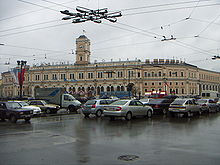Moscow – Saint Petersburg Railway
| Saint Petersburg – Moscow Railway | |
|---|---|

Moskovsky railway station (Saint Petersburg) (1851) is the northern terminus of the line.
|
|
| Overview | |
| Type | High-speed railway |
| System | Russian Railways |
| Status | mostly passenger service |
| Termini |
Leningradsky railway station, Moscow Moskovsky railway station (Saint Petersburg) |
| Operation | |
| Opened | 1851 |
| Owner | Russian Railways |
| Operator(s) | Russian Railways |
| Character | Passenger and freight |
| Rolling stock | Sapsan, ER200 |
| Technical | |
| Line length | 649.7 km (403.7 mi) |
| Track gauge | 1,520 mm (4 ft 11 27⁄32 in) |
| Operating speed | 250 km/h (155 mph) |
The Saint Petersburg to Moscow Railway runs for 649.7-kilometre (403.7 mi) through four oblasts: Leningrad, Novgorod, Tver and Moscow. It is a major traffic artery in the north-west region of Russia, operated by the October Railway subdivision of Russian Railways.
The railway is the second oldest in the country, behind a short line connecting St Petersburg and Tsarskoye Selo. It was a pet project of Pavel Melnikov (1804–1880), an engineer and administrator who superintended its construction and whose statue may be seen near the southern terminus, the Leningradsky railway station in Moscow.
The idea of a railway connecting the two capitals gave rise to a prolonged controversy, with some reactionary officials predicting social upheaval if the masses were allowed to travel. It was decided that only the affluent would be allowed to use the line; every passenger was to be subjected to strict passport and police control.
Nicholas I of Russia, after whom the railway and the termini were named between 1855 and 1923, on 1 February 1842 issued an ukase ordering its construction. It was built by serfs with heavy loss of life, a fact bemoaned by Nikolay Nekrasov in his well-known poem The Railway.
The line was finally opened on 1 November 1851 after almost 10 years of construction and a great deal of financial machinations. The first passenger train left St Petersburg at 11:15 and arrived in Moscow at 21:00 the next day. When completed, the line was the longest double-track railway in the world.
The maximum speed is 250 km/h (155 mph), the fastest train taking 3 hours and 30 minutes. The Siemens Velaro RUS train, also known as Sapsan, has operated on this line since 2009, running below their maximum speed of (300 km/h (186 mph)) because of difficulties upgrading all the track. Russian Railways spent nearly $1 billion on eight trains.
...
Wikipedia
